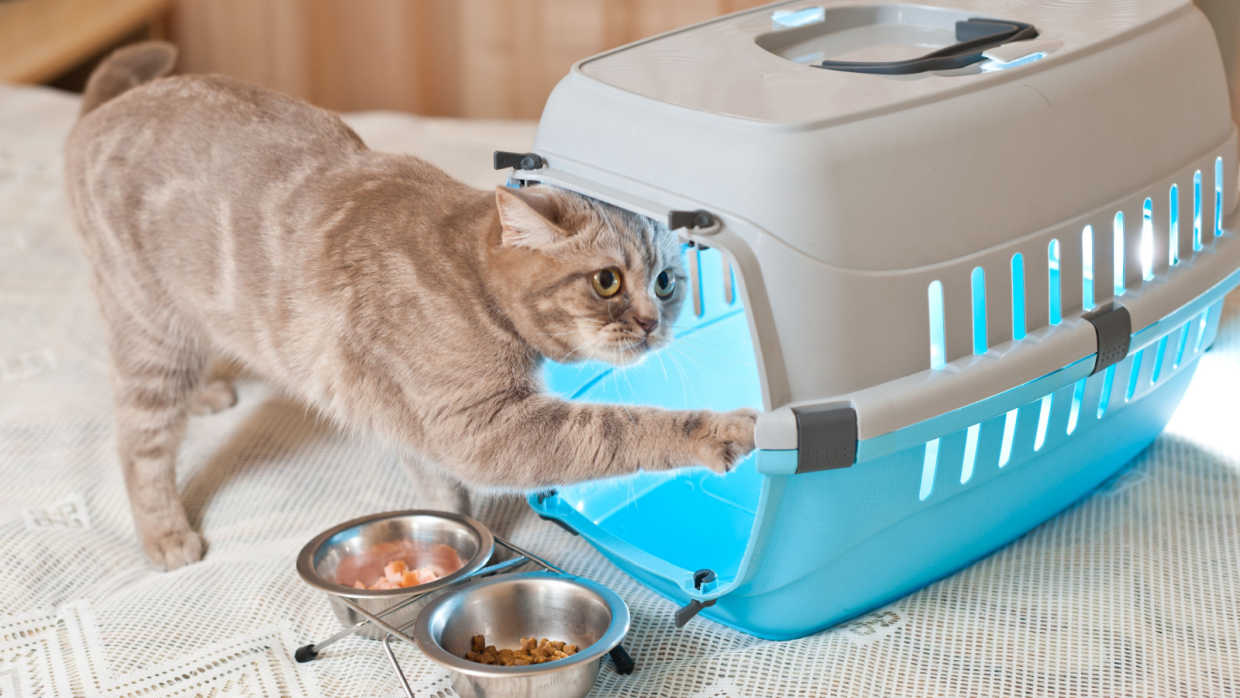Crate training is often associated with dogs, but did you know it can also be a valuable tool for training and acclimating cats? The key to successful crate training for cats lies in patience, consistency and creating a positive association with the crate, such as providing healthy cat food as a reward.
If you are crate training a kitten, you may wonder, can kittens eat adult cat food as a reward? For answers to more cat crate training questions, the following tips can help you transform the crate into a secure and comfortable space where your cat willingly spends time.
Choose the Right Crate
Choosing the right crate for your cat is critical for successful crate training. Wire crates provide excellent ventilation and visibility, allowing your cat to see their surroundings. Plastic carriers offer more privacy and may be preferred by cats who feel more secure in enclosed spaces.
When selecting a crate, consider your cat’s size and comfort. Ensure the crate has enough space for your cat to stand, turn and lie down easily. It should also have a secure latch or lock to prevent accidental escapes.
Additionally, choose a crate with a removable top or a front-loading door for easier access and less stress during entry and exit. Also, consider a crate with a removable tray or one easily disassembled for cleaning.
Get Your Cat Comfortable with the Crate
Begin by placing the crate in a quiet area where your cat spends time. Keep the door open and add soft bedding, toys or familiar scents to make the crate inviting.
Allow your cat to explore the crate at their own pace without any pressure. You can encourage their curiosity by placing RawMix cat food or dry cat food meals near the crate and gradually moving them inside. Cats are curious creatures; given time, they will venture inside the crate to investigate.
Train Your Cat to Enter and Exit the Crate on Command
Training your cat to enter and exit the crate on command can be made easier with treats and clicker training. Start with the crate in a familiar, comfortable space where your cat spends a lot of time. Leave the door open and place some treats inside to encourage exploration. If your cat goes into the crate to get the treats, click the clicker at that exact moment and give another treat as a reward.
The clicker helps mark the behavior you want to reinforce and the treat provides a positive reward. This process is known as “clicker training.”
As your cat starts to enter the crate, use a consistent word or phrase, like “crate” or “go to bed.” When your cat enters the crate, click the clicker and provide a treat. Over time, your cat will associate the command with the action and the reward.
Training your cat to exit the crate on command follows a similar process. Open the door and use a different command, like “out” or “free.” When your cat exits the crate, mark the behavior with a clicker and reward your pet with a treat.
Troubleshooting Crate Training Problems
Crate training can present some challenges, especially since cats are independent creatures and can sometimes resist confinement. However, many issues can be resolved with patience and a few adjustments to your approach.
Fear of the crate
Creating positive associations is critical. Besides placing their favorite toys or comfortable bedding inside to encourage exploration, feed your cat their favorite wet cat food near the crate, gradually moving the food dish inside over time. Never force your cat into a crate, as this can increase fear and resistance.
Refusal to enter the crate
If your cat refuses to enter the crate voluntarily, you might need to make it more appealing. Try placing a piece of clothing with your scent inside or using pheromone spray to create a calming environment. Always reward your cat for entering the crate, even if it’s just to sniff or investigate.
Crying or whining in the crate
It’s normal for a cat to meow or cry initially when crated, as they may be unfamiliar with the confinement. However, don’t let your cat out while crying, as this can reinforce the behavior. Wait until they’re calm before opening the crate. If the crying persists, ensure they are comfortable and your cat gets enough time outside the crate to interact with you.
Litter box issues in the crate
If your cat refuses to use the litter box in the crate, ensure the box is clean and that you’re using the type of litter your cat prefers. The litter box should be large enough for your cat to use comfortably but not so large that it dominates the crate. Also, ensure the crate is big enough for your cat to have a separate area for sleeping and eating.
Start Your Cat’s Crate Training Journey Today
Begin your cat’s crate training journey by creating a positive and comfortable environment within the crate. Gradually introduce your cat to the crate with patience, rewarding them for any interaction or time spent inside.
Combining consistent training techniques with positive reinforcement will help your cat feel safe and secure in their crate. Remember, every cat is different, so adjust your approach as needed and consult your vet if you encounter any challenges.
Open Farm’s range of freeze dried cat food and RawMix foods are ideal treats for crate training your cat. Explore the full selection of sustainably sourced, human-grade cat foods available at Open Farm.
